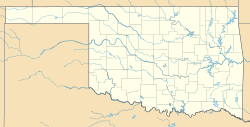First Oil Well in Oklahoma facts for kids
Quick facts for kids |
|
|
First Oil Well in Oklahoma
|
|
| Nearest city | Wapanucka, Oklahoma |
|---|---|
| Area | 5 acres (2.0 ha) |
| Built | 1888 |
| NRHP reference No. | 72001053 |
| Added to NRHP | April 13, 1972 |
The First Oil Well in Oklahoma is a very old oil well site. It is also known as the Old Faucett Well. This historic site is located near Wapanucka in Johnston County, Oklahoma.
The well was drilled by Dr. H.W. Faucett. He started working in 1885 on land belonging to the Choctaw people. This was for a company called the Choctaw Oil and Refining Company. The well was 1,414-foot (431 m) deep. It was not finished until 1888. A small amount of oil and gas was found. However, it was not enough to sell. The well was closed after Dr. Faucett became sick and died later in 1888. The first well in this area that made a lot of oil was the Nellie Johnstone No. 1 well. It was drilled in 1897 near Bartlesville, Oklahoma.
The First Oil Well in Oklahoma was added to the National Register of Historic Places (NRHP) in 1972. Today, only the capped well pipe is left at the site.
Contents
How Oil Was Discovered in Oklahoma
People knew about oil in the area now called Oklahoma for a long time. They often saw oil naturally seeping out of the ground. A historian named Muriel H. Wright wrote about something that happened in 1859. Lewis Ross, whose brother was Cherokee Chief John Ross, was drilling a water well. He owned a salt business in the Cherokee Nation. Instead of water, the well hit oil! It was thought to produce about ten barrels of oil every day for almost a year. The oil stopped flowing when the gas pressure in the ground became too low.
Early Plans for Oil Drilling
Dr. H. W. Faucett, from New York, was one of the first people to see that oil could be a good fuel. He wrote a letter in 1883 to Rev. Allen Wright. Allen Wright was the leader of the Choctaw Nation. Dr. Faucett wanted to make a deal to find oil.
He wrote that it would be hard to get money for the work. This was unless there was an agreement about how much land they could use. Also, they needed to agree on how much money the Choctaw Nation would get from the oil. He asked Allen Wright to write back about what could be done. He wanted to know if his company could have the only right to drill for oil. He also asked if they could have the right to build pipelines to move the oil.
Allen Wright liked the idea. He showed it to the tribal council, which was like the government of the Choctaw people. In October 1883, the council agreed to create the "Choctaw Oil and Refining Company." Its goal was to find oil and help the Choctaw Nation earn more money. This agreement gave the company the only rights to find, move, and refine oil. This covered a huge area of nearly 20,000 square miles (52,000 km2).
Muriel Wright also wrote that Dr. Eliphalet Nott Wright strongly supported Faucett. Dr. Wright was the president of the Choctaw Oil and Refining Company. Sometimes, when money for the project ran low, Dr. Wright used his own money. This helped pay the workers and keep the drilling going. This also helped calm fears that Faucett was causing delays.
Starting the Drilling Work
Faucett's team set up a drilling rig in late 1885. This was on Choctaw land near Clear Boggy Creek. The drilling was very slow. All the supplies had to travel a long way. They were shipped by train from St. Louis to Atoka. Then, they were loaded onto oxcarts. Finally, they were driven 14 miles (23 km) to the drilling site. It was also hard to get money from Faucett's supporters in the East. This also slowed down the work.
Challenges and Setbacks
The Choctaw well project likely started after August 1885. By this time, people from both the Choctaw and Cherokee companies were upset about the delays. Faucett told the Choctaw company that everything was ready. However, the Cherokee project, which was approved later, would start even later. Because of this, the Cherokee council canceled their part of the project. When Faucett's supporters in New York heard this, they also pulled out. This made Faucett find new money in St. Louis. Later, Robert Latham Owen tried to get the Cherokee council to restart the project. But both the Cherokees and the St. Louis supporters had lost interest. So, the Cherokee well was never started again.
The End of the Choctaw Project
The Choctaw project kept going as planned. Finally, the well reached a depth of 1,414 feet (431 m). At this point, it started showing both oil and gas. Faucett became sick at the job site as the work was finishing. He quickly went home to Neosho, Missouri for medical help. But he died soon after. It seems that everyone else involved felt they could not continue without him. So, the Choctaw Oil Company capped the well. They left the site and closed their business.



